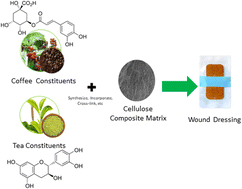Cellulose composites containing active constituents of coffee and tea: a prospective novel wound dressing
Abstract
Cellulose-based wound dressings are increasingly in demand due to their biocompatibility and extracellular matrix (ECM) mimicking properties. Although they contain no active constituents, pure cellulose-based scaffolds have promoted tissue regeneration. On the other hand, the absence of active ingredients opens the opportunity for the wound to become infected through microbial contamination and reactive oxygen, which will prolong the wound healing time. Microbial resistance to antibiotics has also become a problem that needs to be solved by replacing them using bioactive constituents of coffee and tea, which will be incorporated in a cellulose-based biopolymer matrix. Here, we discuss the potential development of a prospective wound dressing using cellulose composites with active ingredients found in coffee and tea. The mechanisms of coffee and tea wound healing properties are discussed, including their in vitro and in vivo characterization.

- This article is part of the themed collection: Recent Review Articles


 Please wait while we load your content...
Please wait while we load your content...